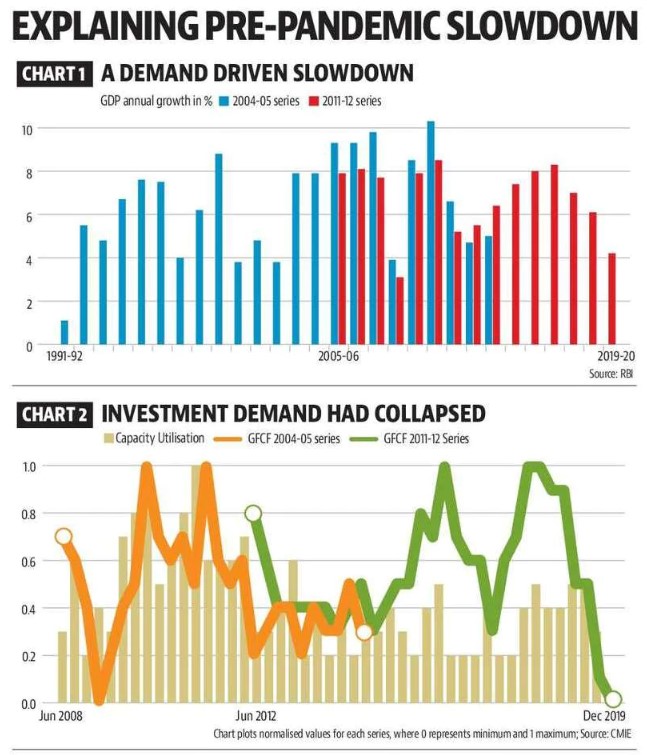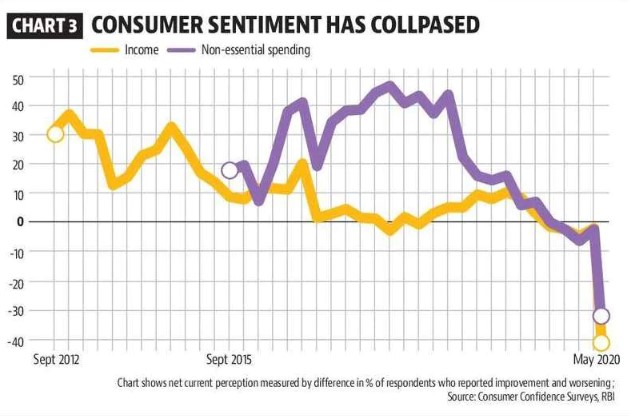Focus: GS-III Indian Economy
Factors that Affect the Economic Impact of the Pandemic
How hard the Economic Impact of the Pandemic will be felt is dependent on three factors:
- The economic situation before the pandemic hit.
- How the pandemic interacts with existing economic and social fault lines.
- The policy response to the pandemic.
India’s Economic situation before the pandemic (Remember only the trend, not the exact numbers)

- India’s GDP growth has been declining since 2017-18.
- GDP growth was 8.3% in 2016-17. It fell to 7% in 2017-18, 6.1% in 2018-19 and 4.2% in 2019-20.
- The economy has never lost growth momentum for three consecutive years since 1991-92.
- Economists classify all problems that are based on linkages into two categories: demand side versus supply side, and structural versus cyclical.
- In December 2019, Chief economic advisor claimed that the economic slowdown is a lot more on the cyclical side.
- India’s growth momentum slowed for three years without an external shock, raises doubts on the validity of claims of a cyclical slowdown.
What is a Cyclical slowdown?
- A cyclical slowdown is a period of lean economic activity that occurs at regular intervals. Such slowdowns last over the short-to-medium term, and are based on the changes in the business cycle.
- Measures to recover from cyclical slowdown:
- Generally, interim fiscal and monetary measures, temporary recapitalisation of credit markets, and need-based regulatory changes are required to revive the economy.
What is a Structural slowdown?
- A structural slowdown, on the other hand, is a more deep-rooted phenomenon that occurs due to a one-off shift from an existing paradigm.
- The changes, which last over a long-term, are driven by disruptive technologies, changing demographics, and/or change in consumer behaviour.
- In such a scenario, a monetary and fiscal stimulus won’t be enough to revive the economy.
- Fixing such problems would require the government to undertake some structural policies. The best example in this regard would be the reforms that were carried out to address the crisis in 1991.
Government’s response
The government’s policy response until 2019-20 was largely a supply-side response such as: slashed corporate tax rates and RBI’s reduced interest rates.
Worsening Situation of Investments
- Investment demand follows capacity utilisation levels.
- Firms will only invest if they can utilise the existing capacity.
- The trend in the last few years shows that businesses did try to invest even when capacity utilisation levels were low.
- Such investments have proved to be unwise. Demand did not grow and capacity utilization levels plummeted further.
Consumer Sentiment Factor

Consumer sentiment seems to be weakening, dragging down demand. RBI’s consumer confidence surveys show that current perceptions on income and non-essential spending have collapsed in the recent period.
Conclusion arguments
- Indian economy was likely facing a demand-driven, perhaps even structural slowdown before the pandemic.
- The policy response most likely misjudged it for a cyclical supply-side problem.
- RBI’s Monetary Policy Committee also pointed to weak demand as a problem in its resolutions on 2019.
- Unfortunately, the only policy tool available to the committee, interest rate cuts, can do little to boost demand.
-Source: Hindustan Times





